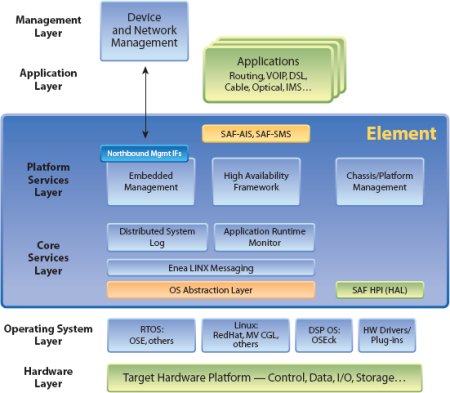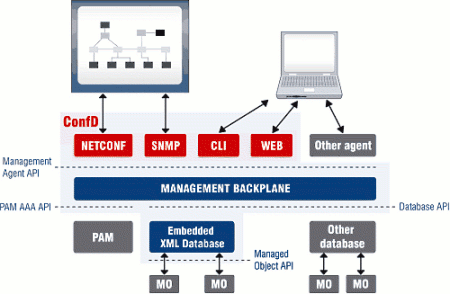High-availability middleware supports “super-clusters”
Oct 16, 2007 — by LinuxDevices Staff — from the LinuxDevices Archive — 1 viewsEnea has enhanced its high-availability middleware product for the second time in two months. Element 2.3 adds support for “super-clusters,” explicit support for Wind River's Carrier Grade Linux, and claimed “industry-first” support for Tail-F Systems's ConfD, a scriptable XML-based system aimed at automating repetitive, failure-prone network management tasks.
Enea is best-known as a vendor of proprietary RTOSes (real-time operating systems) for mobile phones and telecom carrier infrastructure. However, in recent years, the company has been working to diversify both its product and service portfolios — for example by acquiring QiValue, an embedded Linux service provider earlier this year.
Element comprises various “middleware” components that sit between a Linux operating system and the carrier's applications, which are called “service” applications. The components provide event logging, application monitoring, shelf management, fault management, and other services aimed at helping carriers achieve 99.999 percent uptime, or about 5 minutes of downtime or less per year.
Enea last revised Element in August, with a 2.2 release aimed at deeper alignment with Service Availability Forum (SAForum) specs. The previous major release — Element 2.0 — arrived more than a year prior to that.

Element architecture diagram
Atop Enea's list of new features in Element 2.3 is support for “super-clusters,” or clusters of clusters. This makes Element the only available commercial high-availability middleware to support super-clusters, Enea says, suggesting that “the inherent mix of different microprocessor architectures, real-time operating systems, and hardware architectures” makes super-cluster support challenging.
Element 2.3 is said to hide complexities for application developers via a “specialized mixed-endian abstraction layer” claimed capable of marshaling data between disparate architectures automatically. Additionally, enhancements to Element's name server support “additional hierarchy” in the address space, with an eye toward helping system designers eek higher application performance and scalability by better managing “the scope of name publications and subscriptions.”
Additionally, Element 2.3 boasts the industry's “first commercial integration” of ConfD, an XML-based network management scheme from Tail-F systems. ConfD could improve reliability for Element customers by helping them automate “tedious, time-consuming, and failure-prone” tasks inherent in configuring complex distributed equipment, according to Enea. The company announced ConfD integration plans in January.

Tail-f's ConfD can offer on-device Netconf, SNMP, CLI, and/or web interfaces
Finally, Element 2.3 also includes explicit support for Wind River's Carrier Grade Linux operating system and Workbench toolchain, “including cross-compilation for a variety of target architectures,” Enea said. Element has long-supported MontaVista as well, along with Red Hat Enterprise Linux, Fedora Core, and CentOS (Community ENTerprise OS).
Terry Pearson, VP of product management at Enea, stated, “Version 2.3 of Element is the first commercial, high availability middleware framework to include support for super-cluster-based network systems. Element now allows applications in one cluster to communicate with applications in another cluster seamlessly via ENEA's high performance Interprocess Communications Protocol, LINX .”
Element Version 2.3 is available now. Pricing was not disclosed.
This article was originally published on LinuxDevices.com and has been donated to the open source community by QuinStreet Inc. Please visit LinuxToday.com for up-to-date news and articles about Linux and open source.